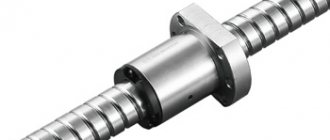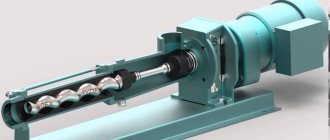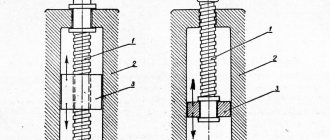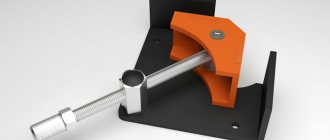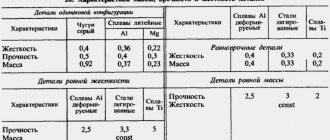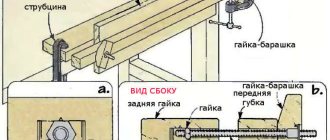A screw conveyor is a universal device for transporting bulk and small-piece materials. The screw conveyor allows you to continuously move products inside an open or closed chute, as well as lift them to a height. Such equipment is simple to set up and operate, small-sized, sealed and convenient for intermediate unloading.
Using a screw, you can significantly mechanize the production process, save time on transportation, and increase the productivity of the enterprise as a whole.
These mechanisms are most popular in enterprises producing feed, flour, grain, and building materials; in mechanical engineering and chemical industry.
How does a screw conveyor work?
Let's look at the design of a screw conveyor, its operating principle and basic parameters. The design of the conveyor body consists of a chute, which is equipped with loading sections. Inside the housing there is a screw (auger) - the main working element. It is rotated by an electric motor. The auger blades grab the load and move it along a line to the outlet pipes. The conveyor screw is a pipe to which the blades are welded.
Operating principle and design of the screw conveyor
The operation of screw conveyors is based on an axial driving force. The screw of the screw conveyor rotates in a closed, stationary chute using an electric motor with a gearbox and two couplings. It is supported by suspension supports: end and intermediate. The body (gutter) consists of sections made of sheet steel. Its thickness varies from 2mm to 6mm depending on the type and purpose of the structure. For sealing, all sections are connected to each other by flanges with bolts and gaskets.
The operation of a horizontal screw conveyor consists of three stages:
- feeding bulk material into the loading hole;
- gradual movement of the load into the unloading hole as the screw rotates;
- unloading.
The conveyor screw slides along the chute and the material moves forward. Sliding bearings are used as supports for the auger. The end thrust bearing absorbs the longitudinal force.
A loading device is used to place the transported material inside the conveyor. This is a hatch in the gutter cover with an inlet pipe that provides a tight seal. The unloading device is the hole in the conveyor chute.
Technical characteristics of the screw conveyor
For each customer, the type of screw conveyor is individually selected according to specific technical characteristics:
- productivity, m3/h;
- screw diameter, mm;
- screw pitch, mm;
- propeller blade thickness, mm;
- screw type;
- maximum transportation length, m, etc.
The layout of the future conveyor and its elements are designed based on the initial data: characteristics of the transported cargo, height and angle of inclination. Also, to select the right type of screw conveyor, you should take into account the direction of movement of the load, the performance of the equipment, and the method of loading materials. The type of conveyor determines how the material is moved: downhill or horizontally. Depending on the type of load and the accepted diameter of the screw, its rotation frequency (rpm) is determined.
Scope of application of screw conveyors
- Screw conveyors are often used in the food industry, such as bakeries, elevators, flour mills, enterprises that produce various types of cereals, pasta, breakfast cereal mixtures.
- Screw conveyors are used in the production of building materials, construction dry mixtures, in mining and engineering, as well as chemical enterprises. Wherever you need to move sand, sawdust, coal, and other bulk materials.
- In agriculture, these units are necessary for moving material intended for sowing and harvesting grain, transporting dry fertilizers, feed and mixtures for feeding birds and animals.
Types of Screw Conveyor
It is necessary to design a screw conveyor taking into account its types and purpose.
Screw conveyors are of a closed type (body ─ pipe) and open type (body ─ chute).
In a closed type conveyor, the auger is mounted in a sealed pipe. At the beginning of the line there is a receiving tray, which is equipped with a lid. The hole at the opposite end of the line is a discharge pipe, which is closed with a valve. Such conveyors are waterproof and airtight, have high productivity and speed of product movement. They are used indoors and outdoors for transporting dusty cargo.
Types of cylindrical conveyors (closed type)
The cylindrical screw conveyor is one of the most common. Its tube-shaped body is rigid, and the unit itself is compact and easy to use. It is suitable for almost all industries. Let's pay attention to its features and additional functions:
- Conveyors are straight, with adjustable angle, and vertical.
- Stationary or mobile.
- Housing and screw material ─ stainless or galvanized steel.
- Equipped with dispensers.
- Speed adjustment and reverse rotation of the auger are possible.
An open type conveyor is a chute or half of a pipe within which a screw rotates. The rectangular container can also be an open conveyor body. The mechanism can only be used indoors, as it is not sealed: moisture and dust may enter. It is desirable that the materials being moved are odorless, do not fly apart, and do not create dust during transportation.
Classification of screw conveyors
Screw conveyors differ and are classified according to basic parameters:
- gutter slope
- spiral direction;
- propeller pitch and diameter;
- screw design.
Classification according to the angle of inclination of the gutter. Define horizontal, gently inclined, steeply inclined and vertical conveyors.
The type of auger blades depends on the type of cargo being transported and the performance of the conveyor:
- solid ones are intended for moving bulk (powdery) materials;
- tape ones are suitable for small lumpy materials;
- blades in the form of individual blades are made for transporting materials that are characterized by stickiness and viscosity;
- shaped blades are suitable if it is necessary to mix the material during transportation.
The shape of the screw is selected depending on the type of cargo being transported.
Depending on the type of conveyor and purpose, its blades move materials at a slope (angle of 45°) up to 30 meters, and horizontally at a distance of up to 40-60 meters.
Completed projects
Construction of elevators, grain complexes. Production of elevator equipment.
Screw design
The operating principle of augers is based on the use of a rotating screw, the spiral part of which is capable of moving material located in the cavities between the body and the screw feather of the auger. This technological scheme is compact and has a high efficiency, which makes screws economical equipment. The simple design allows us to produce specialized models of screws for any production conditions and materials.
There are two kinematic schemes for the operation of a screw conveyor: pulling - when the drive is located on the unloading side, and pushing - when rotation is transmitted to the screw from the loading neck. Each scheme has its own application cases, and is largely determined by the physical properties of the material, the type of screw used and the ability to maintain the drive.
| Rice. 1. Main dimensions of the auger. |
The auger body usually consists of separate sections connected by bolts. For most screws, it has the shape of a cylinder, at the ends of which there are flanges for connecting sections to each other or installing end walls with sealing and bearing units. The body is made of carbon and stainless steels. Eyelets or eye bolts are installed on the outer surface of the auger body for slinging and fastening the product.
Loading and unloading of material is carried out through the corresponding pipes, the number of which is determined by the characteristics of operation. The shape, dimensions and design of the pipes are agreed upon with the Customer. An inspection hatch is located under the loading pipe to clean the auger if it is clogged. A flange is welded to the end of the pipe, which is necessary for a rigid connection of the auger with the valves and other elements of the transport chain. To supply fibrous and low-moving materials, the loading neck is made in the form of a hopper, into which a agitator and/or a product presence sensor is installed.
The main element of any screw conveyor is the feed screw (auger). The shape and design of the feed screw largely depends on the physical properties of the feed material.
A solid screw consists of a pipe with a feather welded in a spiral, the edge of which forms a small gap with the inner wall of the screw body. The screw is subject to mandatory balancing to avoid unwanted vibrations and noise during operation. The pitch of the helical line of the spiral screw is not constant along its length: in the loading zone the step is made smaller than in the main transport zone. A solid screw screw is used to transport materials with high mobility.
The tape screw consists of a pipe on which a wide tape is mounted through intermediate ribs. A feed screw of this design is used:
1) for supplying viscous, thick powders or binding materials that may stick to the screw at the shaft connection;
2) for feeding lump materials such as limestone and gravel;
3) for fast dosing conveyors when good extraction is required.
By installing another belt of a smaller diameter on the shaft of the belt auger, having a pitch with negative thrust, a mixing auger can be obtained.
Belt screws without a central axis are used to transport complex, heterogeneous, viscous or piece products. They can have fastenings at both ends or only on one side, with the end of the belt screw blade sliding along the bottom of the screw conveyor housing.
Blade screws are used on augers, which, in addition to transportation, must pre-mix the product. Often screws of this shape are used to create multi-shaft transport systems.
For materials with poor mobility and high caking, feed screws with a special feather shape can be used.
To transport highly abrasive materials, the edge of the auger feather is strengthened by applying a special wear-resistant coating.
Screw conveyors are often used for volumetric dosing of bulk materials. The main problem with such operation is the difficulty in achieving accurate dosing caused by the undulation of the material supply. To increase the uniformity of product supply, a special device is installed at the discharge end of the screw - a dosing screw, which has a multi-start spiral with a small pitch.
| Rice. 2. blade auger. |
| Rice. 3. Auger dosing screw. |
When working with liquid or highly mobile products, as well as when using screws inclined towards unloading, a siphoning effect is often observed, that is, the outflow of the product when the screw is stopped. To reduce this effect, a special device is used, which is mounted on the shaft of the screw conveyor at the end of the screw feather in front of the outlet pipe.
To ensure the tightness of the screw and prevent particles of the supplied product from entering the bearing units, the feed screw shaft has reliable seals. In order to reduce the likelihood of bearing failure in the event of catastrophic wear of the seals, the bearing and sealing units are implemented in different housings. The shaft seals are manually adjustable and are available on special order with a pneumatic purge system.
Long augers require the installation of intermediate bearing supports (for more information on intermediate supports, see the Spare parts section). These supports are installed inside the auger to support the central axis of the feed screw and transmit torque. The plain bearing is made of bronze or other copper-based alloys. Intermediate screw supports for the food industry are manufactured with self-lubricating, and unlike others, do not require maintenance. Replacement of failed intermediate supports is carried out through inspection hatches located under each support.
The rotation of the screw is usually carried out through a compact two-stage helical gearbox. The gearbox is connected to the auger with a reliable splined connection and a keyed connection to the electric motor. The gear ratio is selected depending on the required rotation speed and productivity of the screw conveyor. When the auger is turned on, a large torque occurs on the output shaft of the gearbox, which can cause gearbox failure. A specially designed safety clutch makes it possible to secure the auger drive in such cases. In addition to gear reducers, a chain or belt drive can be used as a reduction gear.
Electric auger motors are flanged and are designed for operation at temperatures from -25° to +40°C. At the Customer's request, it is possible to install a two-speed electric motor. The engine power is determined based on information about the transported material, the geometric parameters of the auger, the characteristics of the gearbox and the required performance.
see also Screw conveyors when organizing cascades
| What is your name? (FULL NAME.): * | |
| Company name: * | |
| Your contact phone number: * | |
| Your email address (E-mail): | |
| Note: | |
| * Fields are required | |
Features and disadvantages of screw conveyors
Note that the productivity of a screw conveyor is very high only with its high power. When using some types of conveyors, due to their operating principle, the integrity of fragile materials may be compromised. The disadvantages include:
- limiting the length of the device to 40-60 meters;
- during long-term operation of the conveyor, when the cargo is constantly moving, its main part wears out;
- periodic maintenance of the conveyor is required.
This type of transport is not suitable for moving sticky, highly abrasive or compactable substances.
Advantages of screw conveyors
The screw has become widespread in industry due to a number of advantages that will help speed up and modernize production:
- the closed transport housing allows maintaining high tightness of the system;
- the auger is suitable for hot, dusty and toxic materials;
- on the outside, all moving elements are protected by the housing;
- such a conveyor is more compact and easy to use compared to belt and plate devices;
- it is safer to operate and easier to maintain.
Small and dusty cargo is completely stored inside the housing, which minimizes product losses. Inclined units will help save space, because they require less space with the same length (compared to horizontal conveyors). Screw conveyors consist of separate parts and are connected to each other by flange connections. In this way you can easily change the length of the conveyor. Stainless steel, from which all parts of the units are made, prevents oxidation of the transported product.
The compact dimensions of the mechanisms make them possible to integrate into various types of production.
